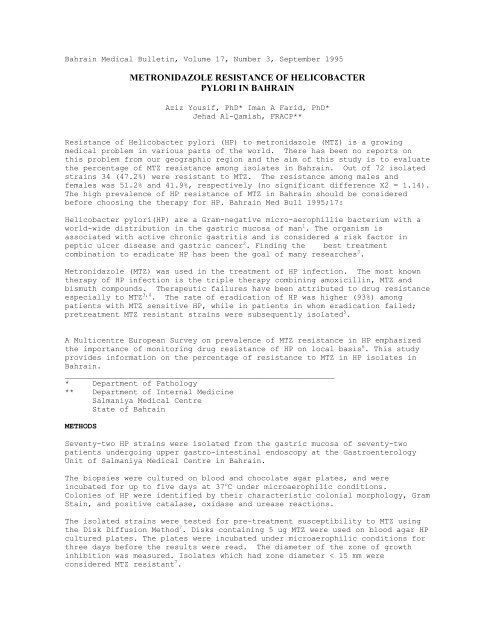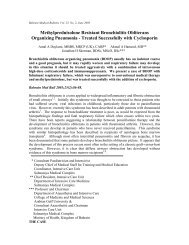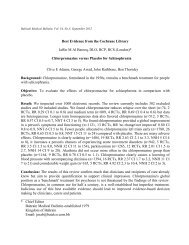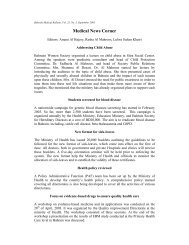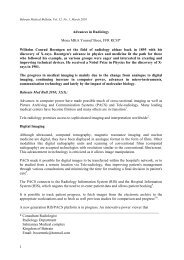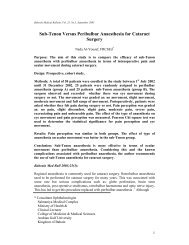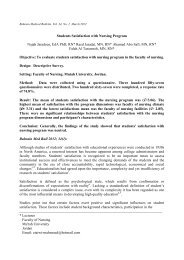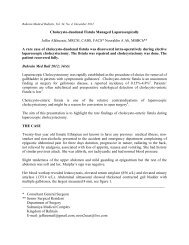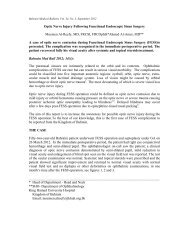METRONIDAZOLE RESISTANCE OF ... - Bahrain Medical Bulletin
METRONIDAZOLE RESISTANCE OF ... - Bahrain Medical Bulletin
METRONIDAZOLE RESISTANCE OF ... - Bahrain Medical Bulletin
You also want an ePaper? Increase the reach of your titles
YUMPU automatically turns print PDFs into web optimized ePapers that Google loves.
<strong>Bahrain</strong> <strong>Medical</strong> <strong>Bulletin</strong>, Volume 17, Number 3, September 1995<br />
<strong>METRONIDAZOLE</strong> <strong>RESISTANCE</strong> <strong>OF</strong> HELICOBACTER<br />
PYLORI IN BAHRAIN<br />
Aziz Yousif, PhD* Iman A Farid, PhD*<br />
Jehad Al-Qamish, FRACP**<br />
Resistance of Helicobacter pylori (HP) to metronidazole (MTZ) is a growing<br />
medical problem in various parts of the world. There has been no reports on<br />
this problem from our geographic region and the aim of this study is to evaluate<br />
the percentage of MTZ resistance among isolates in <strong>Bahrain</strong>. Out of 72 isolated<br />
strains 34 (47.2%) were resistant to MTZ. The resistance among males and<br />
females was 51.2% and 41.9%, respectively (no significant difference X2 = 1.14).<br />
The high prevalence of HP resistance of MTZ in <strong>Bahrain</strong> should be considered<br />
before choosing the therapy for HP. <strong>Bahrain</strong> Med Bull 1995;17:<br />
Helicobacter pylori(HP) are a Gram-negative micro-aerophillie bacterium with a<br />
world-wide distribution in the gastric mucosa of man 1 . The organism is<br />
associated with active chronic gastritis and is considered a risk factor in<br />
peptic ulcer disease and gastric cancer 2 . Finding the best treatment<br />
combination to eradicate HP has been the goal of many researches 3 .<br />
Metronidazole (MTZ) was used in the treatment of HP infection. The most known<br />
therapy of HP infection is the triple therapy combining amoxicillin, MTZ and<br />
bismuth compounds. Therapeutic failures have been attributed to drug resistance<br />
especially to MTZ 3,4 . The rate of eradication of HP was higher (93%) among<br />
patients with MTZ sensitive HP, while in patients in whom eradication failed;<br />
pretreatment MTZ resistant strains were subsequently isolated 5 .<br />
A Multicentre European Survey on prevalence of MTZ resistance in HP emphasized<br />
the importance of monitoring drug resistance of HP on local basis 6 . This study<br />
provides information on the percentage of resistance to MTZ in HP isolates in<br />
<strong>Bahrain</strong>.<br />
___________________________________________________________<br />
* Department of Pathology<br />
** Department of Internal Medicine<br />
Salmaniya <strong>Medical</strong> Centre<br />
State of <strong>Bahrain</strong><br />
METHODS<br />
Seventy-two HP strains were isolated from the gastric mucosa of seventy-two<br />
patients undergoing upper gastro-intestinal endoscopy at the Gastroenterology<br />
Unit of Salmaniya <strong>Medical</strong> Centre in <strong>Bahrain</strong>.<br />
The biopsies were cultured on blood and chocolate agar plates, and were<br />
incubated for up to five days at 37 o C under microaerophilic conditions.<br />
Colonies of HP were identified by their characteristic colonial morphology, Gram<br />
Stain, and positive catalase, oxidase and urease reactions.<br />
The isolated strains were tested for pre-treatment susceptibility to MTZ using<br />
the Disk Diffusion Method 7 . Disks containing 5 ug MTZ were used on blood agar HP<br />
cultured plates. The plates were incubated under microaerophilic conditions for<br />
three days before the results were read. The diameter of the zone of growth<br />
inhibition was measured. Isolates which had zone diameter < 15 mm were<br />
considered MTZ resistant 7 .
RESULTS<br />
Thirty-four of the seventy-two strains isolated, (47.2%) were found resistant to<br />
MTZ. Table 1 shows the MTZ sensitivity according to sex. The resistance among<br />
males and females was 51.2% (21 out of 41) and 41.9% (13 out of 31) respectively<br />
(non significant, x2 = 1.14).<br />
DISCUSSION<br />
Table 1<br />
Results of Metronidazole Sensitivity<br />
in HP isolates according to sex<br />
-------------------------------------------------------<br />
MTZ resistant MTZ sensitive Total<br />
HP HP<br />
No. (%) No. (%) No (%)<br />
-------------------------------------------------------<br />
Males 21 51.2 20 48.8 41 57<br />
Females 13 41.9 18 58.1 31 43<br />
Total 34 47.2 38 52.8 72 100<br />
_______________________________________________________<br />
x2 = 1.14 (non significant difference)<br />
In studying MTZ susceptibility of HP isolates we used Disk Diffusion Method<br />
following Decross et al 1993 who recommended it as a result of a comparative<br />
study of disk, broth and agar dilution methods 7 . They concluded that the Disk<br />
Diffusion Method is practical, accurate and clinically applicable.<br />
The percentage of HP resistance to MTZ in our area is considered moderate<br />
(47.2%). Different percentages of resistance have been reported from different<br />
parts of the world. High percentages of resistance were reported in Zaire<br />
(84%)Italy (73%) and Brazil (64.7%) 4,8,9 . In Europe a Multicentre Survey, from 11<br />
European countries, reported a percentage of resistance ranging from 7% to 49%,<br />
with levels of resistance higher in Africans and other non-Caucasian subjects<br />
than in natives from European countries 6 . The highest percentage of resistance<br />
was reported in Ireland and Belgium (33.87% and 26% respectively) and the lowest<br />
in the Netherlands (6.4%) 8,12,13 . The percentage in the United Kingdom was<br />
20% 10,11 . In Asia, it was reported from an urban region in Malaysia that the<br />
primary resistant rate of HP to MTZ was 10.8% while in the United Arab Emirates<br />
it was observed that 10 out of 16 HP isolates were resistant to MTZ 14,15 .<br />
With regard to the sex-related sensitivity, we found no significant difference<br />
between males and females. Some authors reported similar results whilst others<br />
reported that females have higher MTZ resistant rates than males 4,6,8,12,13,14.<br />
CONCLUSION<br />
It is necessary to test HP susceptibility before treatment in order to select<br />
the most effective therapy to avoid the failure of HP eradication.<br />
REFERENCES<br />
1. Parsonnet J. The epidemiology of C. pylori. In: Baster MJ, ed.<br />
Campylobacter pylori in gastric and peptic ulcer disease. New York: Igaku-<br />
Shoin 1989;51-60.
2. Corless D, Hennigan TW. Surgical aspects of Helicobacter pylori infection.<br />
Post graduate Doctor Middle East 1994;17:214.<br />
3. Hirschi AM. The treatment of Helicobacter Pylori infection. The Sixth<br />
International Congress for Infectious Diseases. Prague-Czech. April 1994.<br />
4. Queriroz DM, Coimbra RS, Mendes EN, et al. Metronidazole-resistant<br />
Helicobacter Pylori in a developing country. Am J Gastroenterol 1993;88:<br />
322-3.<br />
5. Logan RP, Gummett PA, Misiewicz JJ,.et al. One week eradication regimen for<br />
Helicobacter Pylori. Lancet 1992;339:55.<br />
6. Multicentre European Survey. Results of a multicentre European survey in<br />
1991 of metronidazole resistance in Helicobacter pylori. European Study<br />
Group on Antibiotic Susceptibility of Helicobacter pylori. Eur J Clin<br />
Microbiol Infect Dis 1991;11:777-81.<br />
7. De Cross AJ, Marshall BJ, McCallum RW, et al. Metronidazole Susceptibility<br />
Testing for Helicobacter Pylori: Comparison of Disk, Broth, and Agar<br />
Dilution Methods and Their Clinical Relevance. J. Clin Microbiol<br />
1993;31:1971-74.<br />
8. Glupczynski Y, Burette A, Dekoster E, et al. Mettronidazole resistance in<br />
Helicobacter Pylori. Lancet 1990;335:976-7.<br />
9. Tucci A, Varoli O, Corinaldesi R, et al. Evaluation of Helicobacter Pylori<br />
Sensitivity to amoxycillin and metronidazole in dyspeptic patients. Ital J<br />
Gastroentrol 1993;25: 65-7.<br />
10. Weil J, Bell GD, Powell K, et al. Helicobacter pylori and Metronidazole<br />
resistance. Lancet 1990;336:1445.<br />
11. Owen RJ, Bell GD, Desai M, et al. Biotype and molecular finger prints of<br />
metronidazole-resistant strains of Helicobacter pylori from antral gastric<br />
mucosa. J. Med Microbiol 1993;38:6-12.<br />
12. Xia HX, Daw MA, Beattie S, et al. Prevalence of metronidazole-resistant<br />
Heliocabacter pylori in dyspeptic patients. Ir J Med Sci 1993;3:91-4.<br />
13. Becx MCJM, Janssen AJHM, Clasener HAL, et al. Metronidazole-resistant<br />
Helicobacter pylori. Lancet 1990;335:539-40.<br />
14. Parasakthi N and Goh KL. Metronidazole resistance among Helicobacter pylori<br />
Strains in Malaysia. Am J Gastroenterol 1992;87:808.<br />
15. Adeymi EO, Fadlalla H, Al-Homsi M. et al. Clinicopathological assessment of<br />
gastric biopsy samples of patients with Helicobacter pylori infection<br />
metronidazole resistance and compliance problems in the United Arab<br />
Emirates. Ital J Gastroenterol 1992;24:436-9.


